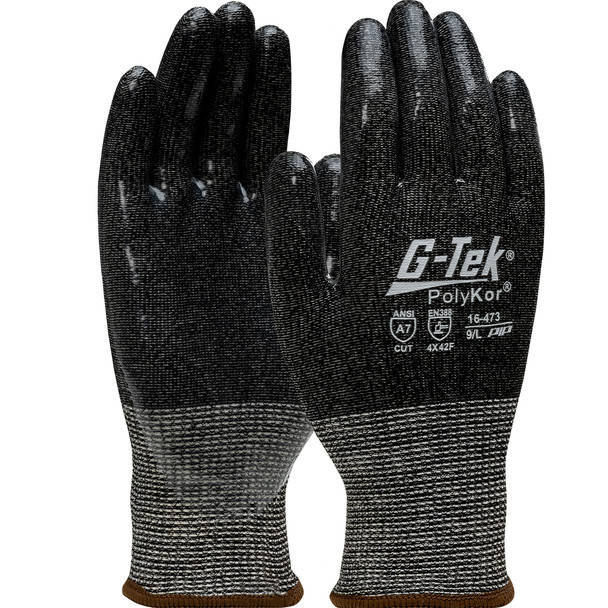Description
PIP 16473 G-Tek® PolyKor® Cut Resistant Work Gloves
Ideal for use in glass manufacturing.
FEATURES:
- Seamless construction offers increased comfort and breathability
- Premium PolyKor® blended shell is lightweight and provides excellent dexterity, tactile sensitivity, and cut resistance
- Silicone coated palm and fingers provide a secure grip in dry conditions, excellent dexterity and heat protection
- Silicone does not absorb liquids and can be wiped off to enhance the grip
- Knit Wrist helps prevent dirt and debris from entering the glove
- Color coded hems for easy size identification
- ASTM F1060-08 Level 1 Contact heat, 3rd party tested
Specifications:
ANSI CUT LEVEL: A7
Test Method: ASTM F2992-15
New edition ANSI/ISEA 105-2016 outlines a new test method for determining cut scores and a revised scale from A1-A9. Click here for more information about the new testing standard.
EN 388 2016 RESULTS: 4X42FX
Abrasion: 4
Cut (Coupe Test): X
Tear: 4
Puncture: 2
Cut (TDM-100 Test): F
Impact Protection: X
EN 388 is a European Standard. Cut Level is determined by the number of cycles it takes a spinning circular blade, that is pulled across the material under a constant weight of 500 grams, to cut the fabric. As the number of cycles increase, so does the glove's ratings. Click here for more information about the EN 388 2016 standard.
ANSI ABRASION LEVEL: 6
Test Method: ASTM D3389-10
The ANSI/ISEA 105-2016 standard outlines test methods for abrasion and is scored from 0-6. The ASTM D3389-10 is used for uncoated gloves and the end point (failure) is the number of abrasion cycles when the first thread or yarn is broken. The larger numbers of cycles indicates greater abrasion resistance of the product and a higher ANSI Abrasion Level.
ANSI PUNCTURE LEVEL: 3
Test Method: ASTM F1342
The ANSI/ISEA 105-2016 blunt force puncture testing uses a probe to simulate a tear or burst hazard. The test measures the amount of force needed for a blunt probe to pierce through PPE material. Results are given in Newtons, which is converted into a 1-5 scale and spans from 10 newtons (Level 1) to 150+ newtons (Level 5) of puncture resistance.
Test Method: ASTM F1060-18
Temperature: 176°F
The ANSI/ISEA 105-2016 standard outlines test methods for contact heat and scored from 0-5. The ASTM F1060-18 test is used to test conductive heat resistance against gloves and PPE. Measuring the highest contact temperature for which the time to second-degree burn is at least 15 seconds and the alarm time is at least four seconds. Learn More
EXTENDED LIFE - REUSABLE/LAUNDERABLE
Reusing or laundering products not only reduces cost, but also reduces the amount of waste that is put into our landfills in turn reducing the environmental impact.








